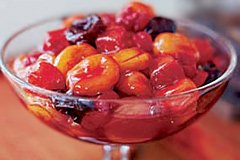Fruit compote may be the most likely culprit which sickened visitors to the Russian pavilion at Folklorama this past August, according to a report published by the Winnipeg Health Region.
The report details the probable cause of the verotoxigenic E-coli and its effect on 37 people who either attended the pavilion or who fell victim to  secondary spread of the E. coli bacterium. Only three of the total 40 cases were not linked to the pavilion. In addition, the report offers a number of recommendations designed to reduce the risk of E-coli outbreaks in the future.
secondary spread of the E. coli bacterium. Only three of the total 40 cases were not linked to the pavilion. In addition, the report offers a number of recommendations designed to reduce the risk of E-coli outbreaks in the future.
According to the "VTEC Outbreak 2010 Report," each person who was treated was interviewed to find the common connection with the pavilion. A study was then undertaken to determine the identity of the specific food item which was contaminated with E-coli, with 33 out of 34 people who attended the pavilion taking part.
Five patients were hospitalized with one case admitted to ICU and seventeen people visited an emergency room. There was one case of hemolytic uremic syndrome. VIP tour group attendees who had not been ill were asked to volunteer to be controls in the study.
The study looked at foods such as borscht, meatballs, a rice dish, and Russian juice (fruit compote). These four items were served together on the "Russian Combination platter." Analysis narrowed down the mostly likely choice to the compote over other sources, partially because the compote was served with both the vegetarian and non-vegetarian platters.
The most plausible source of contamination of the compote juice could have either been from cross-contamination from raw or undercooked ground beef – which is the most common source of E. coli in food products – which was also being handled at the same time in the kitchen or from E. coli contaminated apples used to make the compote.
Interviews with the kitchen staff revealed that most of the food was cooked in a pressure cooker. However, the compote juice was cooked in a .jpg) separate pot. It was prepared by adding washed, unpeeled apples, blueberries and blackberries to boiling water. The fruit was bought fresh from a supermarket in Winnipeg.
separate pot. It was prepared by adding washed, unpeeled apples, blueberries and blackberries to boiling water. The fruit was bought fresh from a supermarket in Winnipeg.
Once boiled for five to 10 minutes, the compote juice was decanted into large 10-litre plastic pails. The boiled compote was then refrigerated until served cold. A new batch of compote was made every day. The only other food item that may have been cooked in the same pot was rice. The fruit was washed before boiling, kitchen staff wore gloves and practiced proper hand washing, and pots were washed and sanitized between use.
